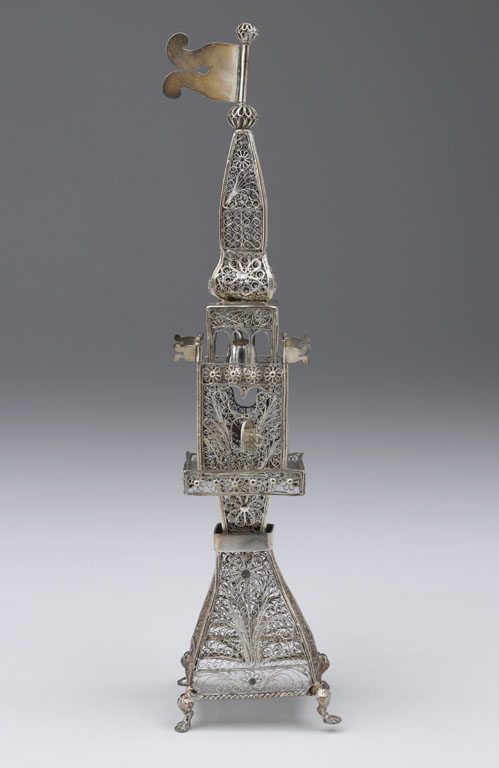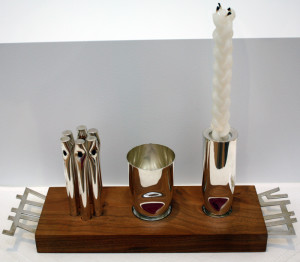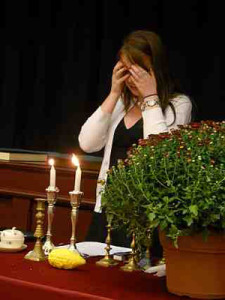
Spice Container
Galician (present-day Poland or Ukraine), circa mid-19th Century
(silver filigree)
North Carolina Museum of Art, Raleigh
Shall we take a look at an object of art that was used in a Jewish ceremony?
If you follow the entries in this blog, you already know that art is something that teaches us about the values people in a community hold most dear. You know that people from many times and places have made art. You know that art is not just something that expresses beauty. Art can be functional as well. What does this mean? It means art can be used in some way. In what way? Art can be worn or used in ceremonies to honor family, to show status and power of leaders, or to practice and enhance a community’s beliefs.
What if I were to tell you this object was used in a ceremony to practice and enhance the beliefs of the Jewish people as well as to express beauty? Would you want to learn about this ceremony and the beliefs pertaining to this ceremony? Jewish people throughout the world practice a religion called Judaism. In Judaism, there are traditions and ceremonies for almost everything, from celebrating the life cycle to celebrating holidays and festivals. To beautify and enhance these ceremonies, art objects are made out of many types of materials, including glass, stone, porcelain, silver, gold, wood and cloth.
Jewish ceremonial art objects can be found in Jewish homes, while others are only found in synagogues. Do you know what a synagogue is? A synagogue is a gathering place that serves as a house of prayer, assembly and study. Let’s learn about the Jewish Sabbath called Shabbat, which is usually performed in the home. As we shall soon learn, this object was used in a ceremony to mark the ending of Shabbat. What is Shabbat exactly? Shabbat intertwines worship into the day-to-day activities of the Jewish people. Shabbat is the most important Jewish holiday. In the Hebrew Bible, Shabbat is the seventh day of creation and is a day of rest. The word “Shabbat” in Hebrew means to rest from work and all creative activity. Shabbat begins weekly on Friday evening just before sunset and ends on Saturday evening when three stars are visible in the sky (about forty minutes after sunset). During Shabbat, which is both a holy day and a day of rest, one engages in a time of spiritual enrichment free from weekly concerns.
Shabbat begins with blessings recited over candles and wine and challah to welcome in the day of rest. Do you know what challah is? Challah is a special braided bread. At sundown on Friday, traditionally the women of the house, perhaps a mother and daughter, light two candles. They place their hands over their eyes and recite a blessing. The family then gathers around the dinner table for a festive meal, which begins with the kiddush, a blessing that is recited aloud over a cup of wine. A special wine goblet called the kiddush cup is used for this. Traditionally, kiddush cups were made of gold or silver. Today, kiddush cups are made from many different kinds of materials, including glass and porcelain. Kiddush cups are sometimes etched with images of fruit, such as grapes, or printed with images of birds or other animals, or inscribed with biblical passages. The kiddush cup is often considered to be a family heirloom and is passed down from generation to generation. The senior male member in the family fills the kiddush cup with wine (or a nonalcoholic beverage) and recites the blessing. The cup is filled to the top. After the blessing has been made, the goblet is passed around the table. Each family member sips the sweet wine to remind him or her of the sweetness of Shabbat. Another blessing is recited over two braided loaves of challah, which are then broken and passed to each family member. Today, traditions differ among families and branches of Judaism. For example, some families will light more than two Sabbath candles, one for each child. Also, in some branches of Judaism, things are more egalitarian in that the roles played by family members will vary.
Shabbat ends with a ceremony called havdalah. The word “havdalah” comes from a Hebrew idiom meaning “separation.” By performing havdalah, one announces the ending of the holy day and the beginning of the work week. In the rituals that usher in Shabbat and those that send it off, one makes a distinction between the holy and the everyday, which otherwise might have passed by unnoticed. The ritual of havdalah contains four simple blessings, during which all the senses are used. First, wine is poured into the kiddush cup so that some of the wine will overflow into a saucer beneath it. After the blessing, everyone sips the wine from the kiddish cup, which symbolically connects the beginning of Shabbat with the ending of Shabbat. A second blessing is said, and a spice container or box that holds fragrant spices such as cloves and cinnamon or herbs is passed around.
Let’s look closely at this object. Do you wonder what it is? It is a spice container that was used in the ceremony of havdalah. All spice containers have holes in them. Why do you think this is so? They have holes in them so the sweet scent of the spices and herbs will waft out into the air. What type of spices and herbs would you put in a spice container if you were participating in this ceremony? Why? What is your favorite smell? How does your favorite smell make you feel? How do you think the spices and herbs make people feel when they take part in this blessing ritual? Refreshed? Tired? Happy? Sad? Sometimes instead of a spice container, an orange with cloves or a sweet plant is passed around. Each family member breathes in the sweet scent of the spices and herbs to remember the sweet moments of Shabbat and help it linger for as long as possible.
What features do you notice about this spice container? It is formed to look like a tower and has some sort of flag on the top and four smaller flags at the mid-section. These narrow, tapering flags are called pennants, which means they are emblems that commemorate federations or leagues perhaps referring to specific towns. Today, pennants are flags that are flown by winning sports teams and ships at sea. If you are lucky enough to see this spice container in person, you will notice that there is a bell inside the tower at the mid-section. This tower-like structure is in a style called Gothic. Gothic refers to a style of art and architecture that flourished during the Medieval period in Europe, which lasted roughly from the fifth century until the fifteenth century. Examples of Gothic architecture include the great cathedrals and churches of Europe as well as the many castles, palaces, town halls and town walls, and universities that were built throughout Europe during this period. Perhaps the tower on this spice container was inspired by the towers of a Medieval church or town hall or wall. As treasures were held in such structures, the spices held within this container represent the “treasures” of the shabbat.
Do you want to know when this spice container was made? It was made during the 1800s in Galicia, present-day Poland or Ukraine. It is typical of the finely crafted ceremonial objects that were produced for Jewish communities in Galicia during this period. You can’t tell from the photograph, but this spice container is quite tall. It is fourteen and one half inches tall. What materials do you think it is made of? I will give you a clue. It is made of a precious material. It is made of silver in a type of metalwork called filigree. What is filigree? Filigree is type of metalwork that is made by twisting threads of gold or silver together and soldering them together. Does the filigree form any kind of patterns? If you look closely, you will notice delicate floral patterns. Do these floral patterns remind you of anything? Do they remind you of the floral patterns one often finds on dainty lace handkerchiefs perhaps? Filigree was popular in Europe for many years. The delicate filigree work and the precious silver tell us the family who owned this spice container celebrated havdalah with an object of unusual beauty.
Shall we continue to describe the ceremony of havdalah? After the spice container has been passed around, a third blessing is said over the flame of a braided candle. According to Judaism, the flame represents the fire that God left uncreated when the first Shabbat set in. After this first Shabbat, it is believed that God gave mankind divine wisdom. Adam and Eve were given the wisdom to take two stones and strike them together to create fire. Followers of Judaism celebrate this by lighting a fire (the flame of the candle) at the end of every Shabbat. The havdalah candle must have at least three wicks. In this way, the combined light of the wicks is stronger than the light the same number of wicks would produce by burning separately. The candle wicks are symbols of the diversity of the Jewish people, who are intertwined and embody strength and unity. Havdalah ends with a final blessing that extinguishes the flame of the candle in the spilled wine.

Havdalah Set, Moshe Zabari, Israeli, 1968
(walnut and silver: hollow-formed, turned, pierced)
North Carolina Museum of Art, Raleigh
Here is an example of a havdalah set done more recently in a modern style. The artist Moshe Zabari has reinterpreted the ornamental style of traditional Jewish ceremonial objects into a more simplified modern style. What does it mean for a style to be modern? In this case, it means the detailed filigree work on the traditional spice container has been simplified and transformed into a style that has a gentle, undulating, smooth form. For those of you who love the history of art, you will be interested to learn that Moshe Zabari studied at the Bezalel Academy of Arts and Design, first called the Bezalel School of Arts and Crafts and founded in Jerusalem in 1906 with the goal of creating a national Jewish style of art.
Let’s look closely at Moshe Zabari’s Havdalah Set. It is made of silver and walnut. On top of a tray made of walnut there are three silver objects. On the left side is a spice container that has been formed and turned and pierced. It looks like a tower of interconnected silvery columns. In the middle is a kiddush cup. The cup has been formed to bend gently inward toward the base. It may just be me, but I can imagine grasping onto the kiddush cup to sip the wine and in the process feel my fingers almost melt into the form. On the right side is a candle holder that holds a three-wicked candle. Like the kiddush cup, the candle holder has been formed to bend gently inward toward the base. If you look closely, you will see that the handles of the walnut tray form Hebrew letters. These letters spell out the words “from sacred to secular,” which refer to the distinction between the holy and the everyday in the ceremony of havdalah.
For those of you who read the many entries in this blog, you already know that artists make art in different ways and in different styles, in part because their environment and time make their work different from the work of other artists in other cultures, times and places. The traditional spice container is a product of a certain time and place. In the same vein, the modern havdalah set reflects the values of modern people today. Compare the traditional spice container to the modern spice container. Which spice container do you like more? The Gothic tower made of silver filigree or the regal modern version made of silver that has been turned and pierced? Why do you prefer one style more than the other?
§
Would you like to see the Spice Container and the Havdalah Set in person? All you have to do is visit the North Carolina Museum of Art in Raleigh, North Carolina. The Spice Container and the Havdalah Set are in the Judaic gallery at the museum. The North Carolina Museum of Art has one of the first permanent galleries devoted to Jewish Ceremonial art in a general museum in the United States, so this gallery is quite special and well worth a visit. Or perhaps you would like a tour. Tours of the collection are given daily, except for Monday when the museum is closed to the public. If you prefer, you can contact the museum ahead of time and arrange for you and your friends to have a private tour. I’m sure a docent at museum would be happy to show you and your friends the Spice Container and the Havdalah Set as well as many other Jewish ceremonial works of art. Whether you visit the museum on your own or have a tour with a docent, it will be well worth your time!
§
I would like to thank Sue Finkel and Connie Shertz for their kind and expert assistance in the points made in my discussion.
